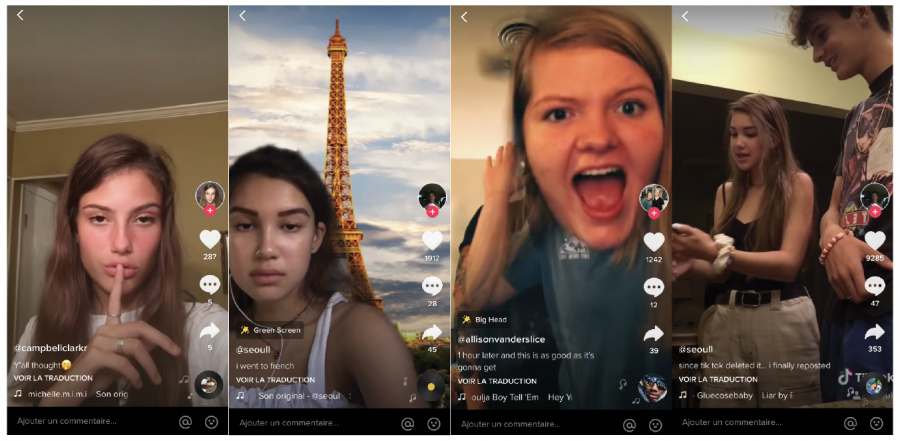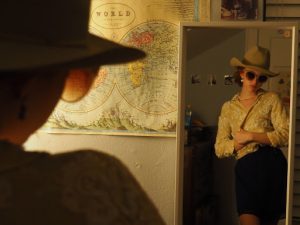TikTok on the clock
The app that is sweeping the nation and the Mac stars who support it
BYTE-SIZED CONTENT: TikTok’s content is limited to short videos, but unlike Vine, the clips can be up to 15 seconds long and can be linked together to create a video up to 60 seconds long.
November 11, 2019
In 2009, “TikTok” was known solely as Ke$ha’s first hit single that launched her into early 2000s fame, but things have changed in the past 10 years. TikTok is no longer the song you listened to in the back of your mom’s car when you wanted to feel rebellious, it’s a platform to share short videos with your followers and, according to the App Store, it’s also 2019’s most downloaded, with over 33 million new users.
Created in September of 2016, TikTok started off as an app akin to Musical.ly, populated by kids lip syncing with their faces pressed far too close to the camera. But after the death of Vine, a 6-second video-making app, in December 2016, a new audience of teenagers was on the search for content to satisfy their short attention spans. They found a home in TikTok and now make up 41 percent of the user population according to Globalwebindex.
Inevitably, with an app as popular as TikTok, some users have gained more notoriety than others, creating people dubbed as “TikTok famous.” Unlike fame gained through more traditional mediums, TikTok fame is confined to the app. The stars live average lives with few benefits from their fame, and there are even three girls with TikTok fame here at McCallum: junior Campbell Race (@campbellclarkr) has 15,700 followers, junior Allison Vanderslice (@allisonvanderslice) has 36,100, and senior Seoul Whitehead (@seoull) has 106,200.
All three girls made their accounts in the late spring/early summer of this year, after 2018’s December user boom when TikTok experienced a 275 percent user growth rate from Dec. 17 to Dec. 18, according to Mediakix. Like many current users, the girls said they didn’t immediately take to TikTok.
“I hated TikTok at first.” Vanderslice said, “I just created [an account] to watch the videos. I didn’t make them for a couple months at first. I wasn’t going to actually make anything, then, I got like one idea and just started making them from there.”
Whitehead reports a similar lukewarm origin story with the app. “Now,” she says, “I’m so addicted.”
Multiple users have found themselves in the same situation. A Business of Apps 2019 study shows that the average teenage user spends 52 minutes on the app every day. This daily dose of nearly an hour of TikTok is spent on comedy skits, trending dances or art videos.
Vanderslice says that the video that caused her online fame was about colored straws, and Campbell Race’s first viral TikTok was a video of her and her friends in a car. Without promoting dangerous ideals, these videos still captured the attention of the public.
Similar to most social media platforms though, some users do misuse the app with malicious intent. Many TikTok stars must deal with creepy or even disturbing comments under seemingly innocent videos. Race reported that she had someone direct message her saying they were at her house watching her. Whitehead says that she has gotten many vulgar comments on her live streams.
“Guys will comment on my lives saying ‘take off your clothes,’” she said. “It makes me uncomfortable, and I always have to end [the live streams] because I don’t know what to do.”
TikTok now has rules in place to prevent dangerous content and interactions. They’ve cracked down on graphic content, nudity, spam, and child endangerment.
“People can’t see my videos because I restricted community guidelines,” she said, “Once I made a Criminal Minds TikTok, and there was a knife in that. They didn’t like that. Then, I made a public school check TikTok that had public school things in it, and they don’t allow that either. They got mad at me.”
A public school check is a TikTok video that presents public school stereotypes.
TikTok has been derided by onlookers and users alike, with even prominent users stating that they have not gotten anything positive out of the app and urging people not to follow them. Defenders of the app, however, say it can have a positive effect.
“It’s helping my ego,” Whitehead said. “I feel like it made me funnier.”
Online validation can not only be a huge confidence booster for many teenagers, but some users are able to make money off of their videos. Some TikTok stars can score deals with brands and donations from prominent fans.
Vanderslice is one of these users. The card game What Do You Meme sends her their games, and about two times a month, she’s posts about them on TikTok. If the video gets more than 100,000 likes, Vanderslice gets paid by the company.
Though Vanderslice is a TikTok star with a brand deal, Whitehead has made money off of TikTok’s “stickers.” The app has a feature where creators with more than 1,000 followers can livestream and have their followers tune in to see them in real time.
While watching the live stream, viewers are offered the opportunity to send “stickers” to the star. These stickers are bought with TikTok coins, purchased in the app with real money and act as currency in the app. TikTok then passes on 80 percent of the sticker’s price to the sticker recipient. Whitehead has live streamed twice and received stickers both times, but she was not aware that she could get money off of them until recently. As of yet, she has not received a payment.
“Where does it go?” Whitehead asked the TikTok creators. “Where’s my money?”
In the end, love it or hate it, TikTok has risen to the top of social media charts, and according to Mediakix, its popularity is trending upward. From 2017 to 2018, the app has gained 530 million users, a 407 percent increase. TikTok seems unstoppable, but, like many apps that came before it, the ride might not last forever.
When will it inevitably join apps like Vine and Flappy Bird in the App Store graveyard?








Jolie Gabriel • Dec 2, 2019 at 1:58 pm
I agree that tik tok is addicting. I will get sucked into tik tok for hours when I’m supposed to be doing something else. TIme seems to go faster when you are watching tik toks.